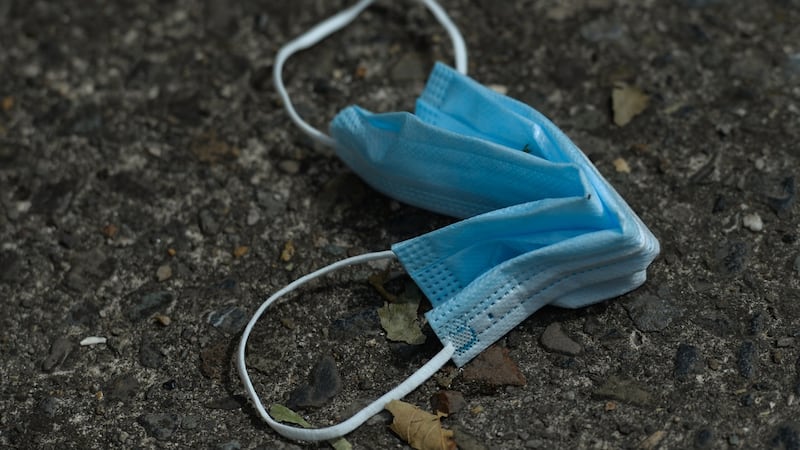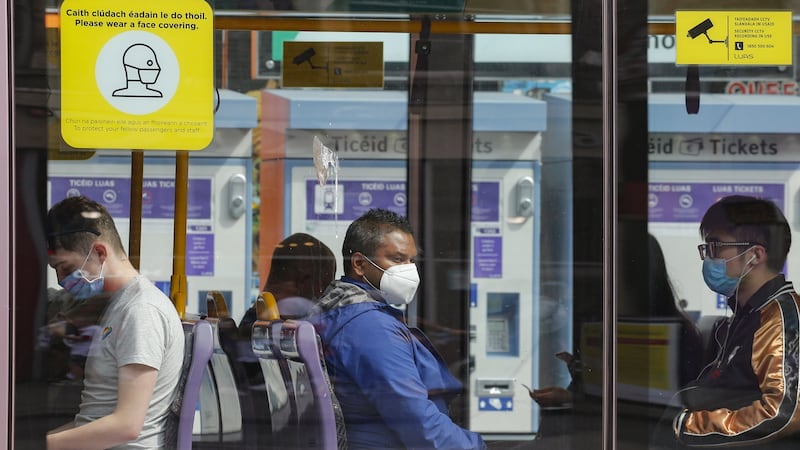Over the past fortnight, more than 200,000 people have tested positive for Covid-19 as yet another pandemic wave washes over Ireland.
That means about one in every 25 people is currently infected, though the true proportion is probably much higher. Since the testing system was largely dismantled at the end of the winter, it is likely many infections have gone unrecorded.
Most of these infections are mild, but the sheer number of cases has translated into more serious illness and massive pressure – again – on hospitals.
This in turn has led to calls from some health and transport worker trade unions, and scientists, for a return to mandatory mask-wearing. The World Health Organisation has suggested Ireland, and many of its neighbours, lifted restrictions "too brutally", thereby contributing to the scale of the current wave.
Covid-19 moves quickly, so much so that the data struggles to keep up; decisions on what to do next have to be made on the best-available information
While many commentators are quick to diagnose and to prescribe solutions for the current situation with enviable certainty, usually in conformity with their existing pandemic worldview, this certainty does not exist. Covid-19 moves quickly, so much so that the data struggles to keep up; decisions on what to do next have to be made on the best-available information.
That said, Ireland seems to have been caught off-guard by this latest wave. It was always likely that cases might rise once restrictions were lifted but the likelihood of another full-blown wave, so soon, was discounted.
No advisory body has yet been constituted to replace the National Public Health Emergency Team, for example. Neither does it appear that any modelling is being carried out to predict the future evolution of cases. Prof Philip Nolan, who presided over modelling efforts earlier in the pandemic, has moved on to a new job heading up Science Foundation Ireland.
The silence from Ministers (other than Tánaiste Leo Varadkar) and senior public health officials is almost deafening at this stage. The officials may feel like a broken record but it is clear many people value the guidance they provide.
Driving factors
To decide what we should do next, we have to better understand what we are dealing with. All Covid-19 waves are driven by changes to the virus, our immunity protection, how we behave and seasonal factors.
The current wave is largely the product of behavioural changes after restrictions were lifted and the rise to dominance of the BA.2 subvariant of Omicron. The World Health Organisation said last week BA.2 made up about 86 per cent of cases reported to it in the previous month. Irish data is scant but officials say it is dominant here.

BA.2 is not new – it emerged at the same time last year as Omicron (BA.1 and BA.1.1 forms) and it differs little from Omicron/BA.1 in terms of vaccine protection. Both variants spread rapidly because they could infect people who were protected from earlier strains of the virus due to infection or immunisation. Omicron also had a shorter incubation time so it could be passed on more quickly. BA.2 appears to have an even shorter incubation time than Omicron/BA.1.
You can gauge how quickly these variants spread from the limited outbreak data currently available. Prisons were largely spared outbreaks in earlier waves of the pandemic but in this wave 174 inmates and staff were infected in one outbreak. The largest nursing home outbreak in this wave involved 129 people and the largest hospital outbreak 94.
While BA.2 is more transmissible it does not appear to be any better than Omicron at evading vaccine immunity. A study in Japan, based on experiments with hamsters, found it causes more severe disease, but according to British and Danish research it does not carry a higher risk of hospitalisation.
The protection provided by vaccines or even prior infection is clearly waning. As a result, more vulnerable people are ending up in hospital. Because Omicron/BA.2 infections occur primarily in the upper respiratory tract, these infections tend to be less severe, which is why ICU numbers have remained relatively stable.
The late arrival of spring this week may help curb the current wave, though based on previous pandemic experience around the world, you wouldn’t bet your house on it.
Changed behaviour
That leaves the fourth factor dictating the rate of infection: our behaviour. The US-based Institute for Health Metrics and Evaluation asserts that changes in behaviours, particularly declines in mask-use and social distancing – and not BA.2 – may be the most important explanation for the increasing case numbers in Europe. The WHO and others lay the reason for the increase at the door of BA.2.
In January and February, Nphet was split on the decision to quickly lift all restrictions, which went ahead after it was backed by a majority of members and approved by Government.
That decision is spilt milk now, and there seems to be little political appetite for reimposing a mask mandate
Some of those involved still regret that decision, not so much for its content as the message it sent out. “We basically told people to throw away their masks, when many weren’t ready for it,” one member says now. “We could have approached things more gradually.”
“We gave a clear signal that the pandemic was over, which we didn’t have to do,” says another health service source.
That decision is spilt milk now, and there seems to be little political appetite for reimposing a mask mandate. People are free to continue wearing masks if they wish, the counter-argument goes; there has been a noticeable increase in mask-wearing in recent weeks as the public recalibrates its perception of the threat posed by the virus.
In early March, two-thirds of shoppers and public transport users reported they continued to wear a mask, according to surveys carried out for the Government.
A mask mandate would probably reduce infections somewhat but not immediately, so the current pressures on the health service are likely to continue for a time regardless of any policy change.
Hospitals and sickness
These pressures are considerable. Over 1,300 patients with Covid-19 were in hospital this week; there were more new admissions on Wednesday than at any point in the pandemic. In Kerry University Hospital in Tralee, more than 100 out of 250 beds were occupied by Covid-19 patients.
Over 5,000 hospital staff are off work, and another 1,000 from care homes. These figures have been higher at earlier points in the pandemic, but on those occasions most of the absences were due to isolation rules; this time around, all of the staff involved are sick.
With entire teams off sick, there is massive disruption of normal work and elective procedures are being cancelled once again. A new plan to cut waiting lists, launched only weeks ago, has already been placed on hold.
The health service will muddle through this latest challenge, but once more this will come at the cost of longer waiting lists and delays in non-urgent patient care.
All this will be manageable if cases peak soon, but will they?
In the absence of modelling, it is impossible to make predictions. The experience of other countries gives cause for hope. Denmark, which hit the BA.2 peak first, is seeing case numbers fall rapidly, and infections are declining also in The Netherlands.

It is thought infection with Omicron/BA.1 or BA.2 will protect against reinfection by either strain, so the available reservoir of potential infections is shrinking all the time. Antivirals are available that work against both variants, but availability in Ireland is poor compared to the US.
The Health Service Executive has not published age-stratified data on Covid-19 recently but, anecdotally, the wave of cases among schoolchildren of a few weeks ago seems to have settled down. It may be that the same will soon happen with the adult population.
Calls for the reintroduction of mask mandates are rooted in an understandable desire for demonstrable actions to be taken. But such a step would be socially divisive and hard to enforce. A better approach might be to nudge people into greater personal protection if they feel under threat. Donegal GP Dr Denis McCauley has advised people to “put your mask in your back pocket again” and use it in crowded settings.
The only certainty for now is that next week will be another rough one for the health service, with more Covid-19 patients in hospital and more cancellations of important services.


















